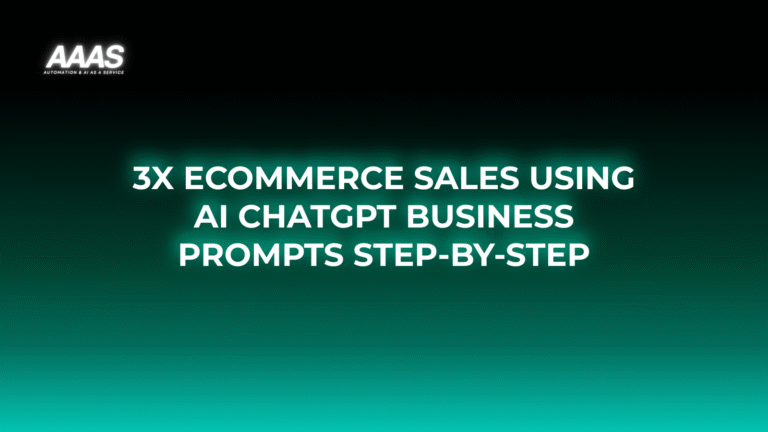Boost Online Sales: Step-by-Step Guide to AI ChatGPT Business Prompts for E-commerce Sales Optimization

Last updated: October 31, 2025
Market Problem: E-commerce Conversion Challenges
Despite increasing website traffic, average e-commerce conversion rates remain between 2% and 3% (Shopify). This leaves the majority of visitors disengaged, often due to:
- Complicated navigation
- Lack of real-time support or product guidance
- Ineffective cross-sell or upsell strategies
- Lack of personalized shopping experiences
- High cart abandonment rates
Solution: AI-powered ChatGPT Business Prompts
Integrating ChatGPT-based AI prompts into e-commerce stores provides instant, personalized guidance to shoppers — overcoming buying hesitations, answering questions, and nudging conversions exactly when and where it’s needed.
Key Benefits
- 24/7 automated sales assistants
- Highly personalized product recommendations
- Proactive cart recovery messages
- Dynamic answers to product and shipping queries
- Automated cross-sell/upsell based on user behavior
- Increased buyer confidence and reduced friction
Real Use Cases
- Conversion Boost: ShopX embedded ChatGPT-powered chat on product pages, resulting in a 24% rise in completed sales.
- Cart Abandonment Reduction: GadgetStore uses AI prompts to offer personalized discounts to cart abandoners, reducing abandonment by 32%.
- 24/7 Support: ApparelHub employs ChatGPT to instantly handle sizing, shipping, and returns inquiries — leading to higher customer satisfaction scores.
- Dynamic Cross-Selling: AccessoryWorld’s ChatGPT bot suggests matching products in real time, increasing average order value (AOV) by 17%.
Technical Implementation Details
Integration Methods
- Direct API Call: Use OpenAI’s GPT API for backend integration and custom chat widgets.
- Third-Party Apps: Platforms like Tidio or Gobot offer plug-‘n’-play ChatGPT chat for Shopify, WooCommerce, BigCommerce, Magento, and others.
- Custom Widget Embedding: Add code snippets directly to key shop pages or via tag managers (e.g., Google Tag Manager).
Prompt Engineering for Sales
- Structure prompts to encourage buying action (e.g., “Can I help you find a matching accessory for this shirt?”).
- Utilize user session data: recently viewed items, cart items, or referrer URLs.
- Ensure prompts are context-aware — e.g., instant FAQ on shipping when a user pauses at checkout.
Data & Privacy Considerations
- Ensure user conversations comply with GDPR and local data privacy laws.
- Implement opt-in notices for AI-powered assistance.
Comparison: ChatGPT vs. Alternative Tools
| Feature | ChatGPT Business Prompts | Static Live Chat | Rules-based Chatbot |
|---|---|---|---|
| 24/7 Intelligent Support | Yes (AI-driven) | Operator-dependent | Limited preset cases |
| Personalized Recommendations | Advanced (context-aware) | No | Basic patterns |
| Scalability | High (automated) | Manual agent scaling | Moderate |
| Complex Query Handling | Yes | Depends on operator | No |
| Integration Complexity | Low–Medium | Low | Medium |
Pricing & Cost Structure
| Solution | Pricing Model | Estimated Monthly Cost* |
|---|---|---|
| OpenAI GPT-4 API (direct) | Usage-based | $20–$150+ (depends on volume) |
| Tidio ChatGPT Integration | Tiered subscription | $39–$499 |
| Gobot AI Shopify App | Monthly subscription | $49–$249 |
*Varies based on store size and message volume. Check current vendor pricing.
ROI-Focused Practical Examples
- Case: Store with 50,000 monthly visitors @ 2% base conversion rate (1,000 sales). Adding AI chat prompts raises rate to 2.6% (>1,300 sales/month).
- Revenue: 300 extra monthly sales at $60 AOV = $18,000 added revenue/month.
- Cost: ChatGPT tool at $100/month = ROI of 17,900%.
- Soft Benefits: Lower support costs, reduced manual intervention, better customer feedback.
Step-by-Step Setup Tutorial
- Define Sales Goals: Choose KPIs (conversion rate, AOV, cart recovery).
- Select Platform: Decide on direct API (developer resources) or plug-in app (e.g., Tidio, Gobot).
- Register & Obtain API Keys: Sign up at OpenAI for API or subscribe to your chosen app.
- Install Chat Widget: Add code snippet to your theme, or install via app marketplace.
- Craft High-Converting Prompts: Use language that helps, nudges, and guides (e.g., “Would you like to see trending offers in your size?”).
- Test Chatbot Behavior: Emulate customer journeys, test all prompt branches, and refine based on performance.
- Monitor & Adjust: Analyze chat transcript data, optimize prompt flows, and tweak CTAs weekly.
- Ensure Compliance: Display privacy statements and enable opt-in where required.
- Train Support Team: Educate customer service on AI escalation and monitoring best practices.
- Promote Chat Feature: Highlight it on banners, emails, and social for maximum adoption.
Pros and Cons of ChatGPT Business Prompts in E-commerce
| Pros | Cons |
|---|---|
|
|
Expert Tips for Maximizing Sales with AI Chat Prompts
- Continuously refine prompts with real chat data insights.
- Personalize messages using browsing/cart data for higher engagement.
- Set escalation triggers for complex or sensitive customer concerns.
- Use AI chat support to collect zero-party data for marketing.
- Regularly A/B test new prompt variations and calls-to-action.
- Integrate with CRM or helpdesk for seamless handoff to human agents if needed.
Frequently Asked Questions (FAQ)
- Is ChatGPT integration secure for online stores?
- Yes, when implemented via secure APIs and in compliance with privacy standards such as GDPR.
- Which e-commerce platforms support AI chat prompts?
- Platforms like Shopify, WooCommerce, Magento, BigCommerce, and custom builds via API.
- Will AI replace human sales agents?
- No, AI augments sales by handling routine queries and nudging conversions. Complex cases can be escalated to human agents.
- How can I measure the impact of ChatGPT prompts?
- Track KPIs: conversion rates, average order value, chat engagement rates, and cart abandonment metrics.
- Are there ongoing maintenance requirements?
- Regular prompt tuning, compliance checks, and monitoring chat logs for quality assurance.
References & Citations








